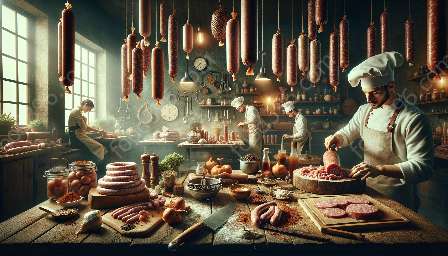When it comes to creating mouthwatering sausages, understanding the various cookery methods, sausage making, and food preservation & processing is essential. In this comprehensive guide, we will explore these topics in detail and provide practical tips and techniques to help you prepare delicious sausages.
Sausage Making
Sausage making is an art that has been perfected over centuries. The process begins with selecting the right cuts of meat, grinding them, and mixing them with a blend of spices and seasonings. Depending on the type of sausage being made, additional ingredients such as fresh herbs, garlic, and wine may be added to enhance the flavor profile.
After the ingredients are thoroughly mixed, they are typically stuffed into natural or synthetic casings. Natural casings, often made from animal intestines, provide an authentic look and texture to the sausages, while synthetic casings offer consistency and convenience.
Once the sausages are stuffed, they can be linked into individual portions or left in long coils. Properly prepared sausages can be stored in the refrigerator for a few days or frozen for longer-term preservation.
Food Preservation & Processing
Preserving sausages involves understanding the fundamentals of food preservation and processing. This may include techniques such as curing, smoking, and fermenting.
Curing, which involves using salt and nitrites, helps enhance the flavor of sausages while also inhibiting bacterial growth. It is a critical step in preserving sausages and ensuring their safety for consumption. Smoking, on the other hand, infuses sausages with rich, smoky flavors and contributes to their preservation by reducing moisture content and inhibiting bacterial growth.
Fermenting sausages involves introducing lactic acid bacteria, which not only enhances the flavor and texture of the sausages but also contributes to their preservation.
Sausage Cookery Methods
Once the sausages are made and preserved, there are various methods for cooking them to perfection. These methods include grilling, pan-frying, baking, boiling, and broiling.
- Grilling: Grilling sausages over an open flame imparts a delicious smoky flavor and creates beautiful grill marks. It's essential to cook sausages over medium heat, turning them frequently to ensure even cooking.
- Pan-Frying: Pan-frying sausages in a skillet with a small amount of oil enables you to control the cooking temperature more precisely. This method is ideal for achieving a crispy, golden-brown exterior.
- Baking: Baking sausages in the oven allows for hands-free cooking and ensures even heat distribution. This method is particularly suitable for cooking a large batch of sausages at once.
- Boiling: Boiling sausages in flavorful liquid, such as beer or broth, can infuse them with additional taste and moisture. Once boiled, they can be finished on the grill or in a hot skillet for added texture.
- Broiling: Broiling sausages in the oven under high heat can produce a beautifully caramelized exterior and juicy interior. It's important to monitor the cooking process closely to prevent burning.
Each of these cooking methods has its unique advantages and can be adapted to different types of sausages based on their flavors and ingredients. Whether you're looking to savor a classic bratwurst or enjoy a spicy chorizo, understanding the various cooking techniques will help you achieve delicious results.
In conclusion, mastering sausage cookery methods, sausage making, and food preservation & processing is a rewarding journey that allows you to savor the rich flavors of homemade sausages. By combining quality ingredients, traditional techniques, and innovative cooking methods, you can create memorable culinary experiences for yourself and your loved ones.

